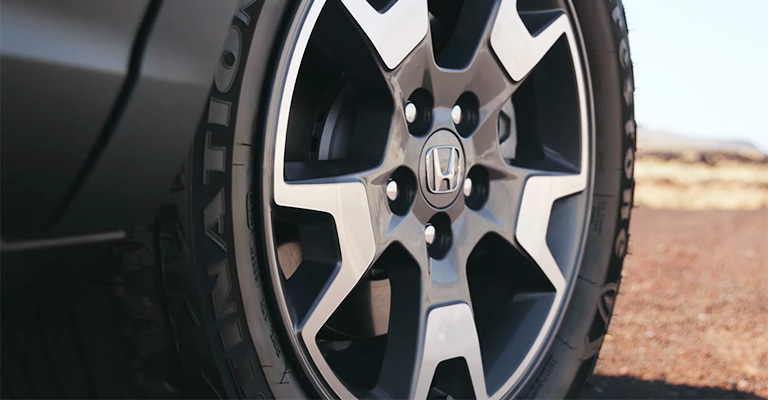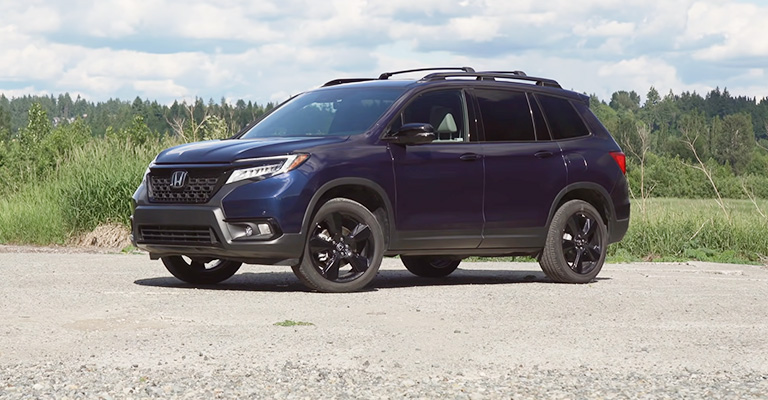The Honda Passport is a mid-size SUV that has gained popularity for its reliability, comfort, and versatility.
One important aspect of customizing a vehicle is ensuring that the wheels and tires fit perfectly in size and bolt pattern. A vehicle’s bolt pattern refers to the number of bolt holes and the distance between them on the wheel hub.
The Honda Passport Bolt Pattern is a key specification determining which aftermarket wheels and tires will fit the vehicle.
In this introduction, we will discuss the Honda Passport Bolt Pattern, why it is important, and how to determine the correct bolt pattern for your Honda Passport.

List of Honda Passport Models and Their Respective Bolt Patterns
Here is a comprehensive list of Honda Passport models and their respective bolt patterns
- 1994-1997 Honda Passport: 6×139.7 bolt pattern, 15×7 wheel size, 6mm offset
- 1998-2002 Honda Passport: 5×114.3 bolt pattern, 16×7.5 wheel size, 35mm offset
- 2019-2023 Honda Passport: 5×120 bolt pattern, 20×8 wheel size, 50mm offset
It is important to note that the bolt pattern, wheel size, and offset can vary depending on the year and model of the Honda Passport.
You must check the owner’s manual or consult a professional mechanic to determine the correct specifications for any aftermarket wheels or tires you plan to install on your vehicle.
Using the wrong bolt pattern or wheel size can result in improper fitment, decreased performance, and even safety issues.

Here is a table for the Honda Passport Bolt Pattern, with the model name and displacement in the top row and the bolt pattern in the second row
| Model Name & Displacement | Bolt Pattern |
|---|---|
| 1994-1997 Honda Passport | 6×139.7 (6×5.5) |
| 1998-2002 Honda Passport | 5×114.3 (5×4.5) |
| 2019-2023 Honda Passport | 5×120 |
In addition to the bolt pattern, other specifications, such as the wheel size, offset, and recommended tire size, may also vary depending on the year and model of the Honda Passport.
It is important to check the owner’s manual or consult a professional mechanic before purchasing aftermarket wheels or tires to ensure proper fitment and safe operation of the vehicle.
Other Fitment Specs You Should Know
In addition to the bolt pattern, here are some other fitment specifications that you should know when selecting aftermarket wheels or tires for your Honda Passport
Wheel Size
The wheel size refers to the diameter and width of the wheel, usually measured in inches.
The wheel size can affect the vehicle’s handling, performance, and appearance. The Honda Passport typically uses wheel sizes ranging from 15 inches to 20 inches, depending on the year and model.
Offset
The offset refers to the distance between the centerline of the wheel and the mounting surface. A positive offset means that the mounting surface is toward the front of the wheel, while a negative offset means that it is toward the back. The correct offset can ensure proper clearance between the wheel and the suspension, brakes, and other components.
Hub Bore
The hub bore refers to the size of the hole in the center of the wheel that fits over the vehicle’s hub. The wheel’s hub bore must match the vehicle’s hub diameter to ensure proper centering and prevent vibration.
Recommended Tire Size
The recommended tire size refers to the size and type of tire that the manufacturer recommends for the vehicle. Selecting a tire with the correct size, load rating, and speed rating for your Honda Passport is important to ensure proper performance and safety.
Load Capacity
The load capacity refers to the maximum weight that the wheel and tire can support. It is important to select a wheel and tire combination that can handle the weight of your vehicle and any additional cargo or passengers.
Considering these fitment specifications, you can select aftermarket wheels and tires that fit and function properly on your Honda Passport.
Honda Passport Other Fitment Specs Per Generation
Here is a table for Honda Passport fitment specifications per generation
| Generation | Years | Bolt Pattern | Wheel Size | Offset | Hub Bore | Recommended Tire Size |
|---|---|---|---|---|---|---|
| 1st | 1994-1997 | 6×139.7 (6×5.5) | 15×7 | 6mm | 108mm | 235/75R15 |
| 2nd | 1998-2002 | 5×114.3 (5×4.5) | 16×7.5 | 35mm | 108mm | 245/70R16 |
| 3rd | 2019-2022 | 5×120 | 20×8 | 50mm | 64.1mm | 245/50R20 |
Note that these fitment specifications are for the US market and may vary in other regions. It is important to consult the owner’s manual or a professional mechanic to determine your vehicle’s correct fitment specifications.
Other fitment specifications, such as lug nut size, may also vary and should be considered when selecting aftermarket wheels or tires.
Why Knowing Blot Pattern is Important?
Knowing the bolt pattern of your vehicle is important when selecting aftermarket wheels or tires for several reasons
Proper Fitment
The bolt pattern specifies the number and spacing of the bolts that attach the wheel to the vehicle hub. Selecting wheels with the correct bolt pattern ensures that they will fit properly on the hub and be secured by the lug nuts.
Choosing wheels with an incorrect bolt pattern can cause fitment issues, such as incorrect centering, interference with brake components, or improper clearance with the suspension or bodywork.
Safety
Wheels that do not fit properly can compromise the safety and handling of the vehicle. If the wheels are not centered on the hub, they can cause vibration, steering instability, or even wheel detachment. Choosing wheels with the correct bolt pattern ensures that they are securely fastened to the hub and will not cause these issues.
Appearance
Selecting wheels with a bolt pattern that matches the vehicle’s hub can help achieve the desired aesthetic look for the vehicle. Wheels that do not match the vehicle’s bolt pattern can appear misaligned or out of place and detract from the vehicle’s overall appearance.
Cost
Choosing wheels with an incorrect bolt pattern can incur additional costs, such as replacing the wheel studs or hubs to accommodate the wheels. Selecting wheels with the correct bolt pattern can prevent unnecessary expenses.
Knowing your vehicle’s bolt pattern is important to ensure proper fitment, safety, appearance, and cost-effectiveness when selecting aftermarket wheels or tires.
How do you measure the Honda Passport Bolt Pattern?
Here are the steps to measure the bolt pattern of a Honda Passport
Count the Number of Lugs
The first step in measuring the bolt pattern is to count the number of lugs on the wheel hub. The Honda Passport has either a 5-lug or 6-lug pattern, depending on the year and model.
Measure the Diameter of the Bolt Circle
The bolt circle is the imaginary circle that passes through the center of each bolt hole. To measure the bolt circle, take a straight edge or ruler and measure the distance between the center of any bolt hole and the center of the hole directly across from it. This measurement is known as the bolt circle diameter (BCD).
Determine the Bolt Pattern
Once you have the BCD measurement, you can determine the bolt pattern by counting the number of bolt holes on the wheel hub and measuring the distance between them.
For example, if you have a 5-lug hub and the BCD measures 4.5 inches, then the bolt pattern is 5×114.3, meaning there are 5 bolts, and the distance between each bolt hole is 114.3mm.
It is important to note that there may be exceptions to the bolt pattern depending on the specific year, model, and trim level of the Honda Passport. It is always recommended to consult the owner’s manual or a professional mechanic to confirm the correct bolt pattern for your particular vehicle.
Additionally, some aftermarket wheels may have a multi-fitment design that allows them to fit multiple bolt patterns. In these cases, it is important to ensure that the wheels are compatible with the specific bolt pattern of the Honda Passport to ensure proper fitment and safety.
How to Tighten Honda Passport Bolts?
Here is a detailed guide on how to tighten the bolts on a Honda Passport
Determine the Correct Torque Specifications
The first step in tightening the bolts on a Honda Passport is determining the correct torque specifications for your particular year, model, and trim level. These specifications can be found in the owner’s manual or obtained from a professional mechanic.
It is important to use the correct torque specifications to ensure that the bolts are tightened to the appropriate level and prevent over-tightening, which can cause damage or failure of the bolts.
Use a Torque Wrench
Once you have determined the correct torque specifications, use a torque wrench to tighten the bolts to the recommended level. A torque wrench is a specialized tool that allows you to measure and control the amount of force applied to the bolt.
When using a torque wrench, it is important to apply the force gradually and evenly, using a criss-cross pattern to ensure that the bolts are tightened evenly.
Tighten the Bolts in Stages
When tightening the bolts on a Honda Passport, tightening them in stages rather than all at once is important. This helps to ensure that the bolts are evenly tightened and reduces the risk of over-tightening.
Start by tightening the bolts to about 30-40% of the recommended torque specification, then tighten them again to about 60-70% of the specification, and finally, tighten them to the full recommended torque specification in a criss-cross pattern.
Check the Tightness of the Bolts
After tightening the bolts to the recommended torque specification, it is important to check the tightness of the bolts again after a short period of driving. This is because the bolts can sometimes loosen slightly during the initial period of use.
Check the tightness of the bolts again after driving for about 50-100 miles and tighten them as needed to ensure that they remain at the recommended torque level.
It is important to follow these steps when tightening the bolts on a Honda Passport to ensure that they are tightened to the appropriate level and prevent damage or failure of the bolts.
If you are not comfortable performing this task yourself, it is recommended that you have a professional mechanic perform this service for you.
Final Words
Knowing a Honda Passport’s bolt pattern and other fitment specifications is important when selecting replacement wheels or tires. The bolt pattern is determined by the number of lugs and the distance between them and can vary by year, model, and trim level.
It is also important to use the correct torque specifications and tighten the bolts in stages when performing maintenance on the vehicle.
Following these guidelines will ensure that the wheels and tires are compatible with the vehicle and that the bolts are properly tightened to prevent damage or failure.
Consult the owner’s manual or a professional mechanic to ensure proper fitment and safety when in doubt.
Check Other Honda Models Bolt Pattern –

Leave a Reply